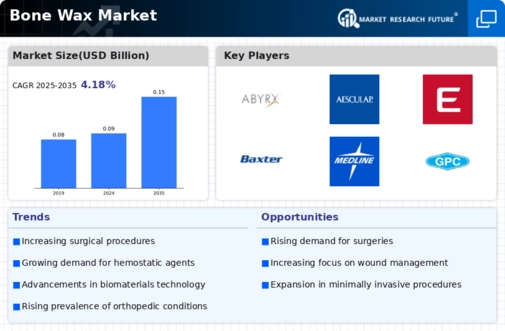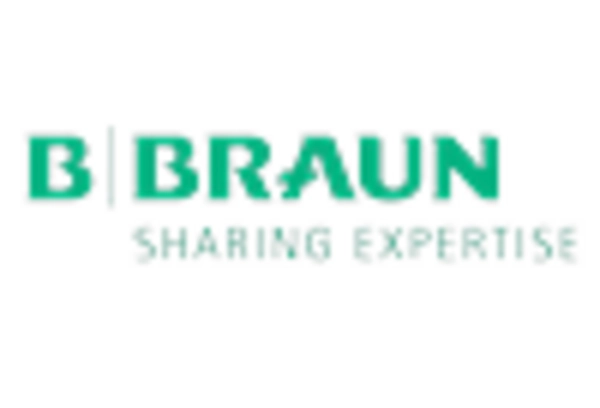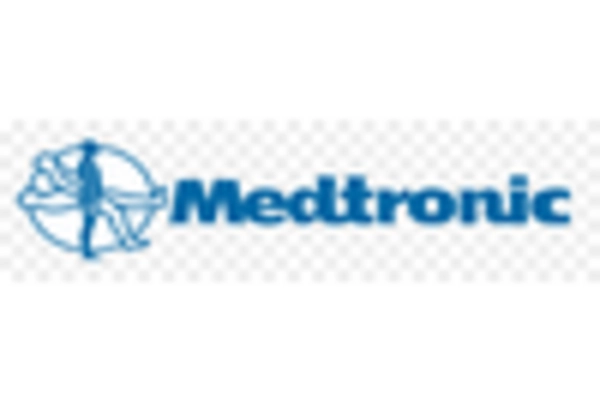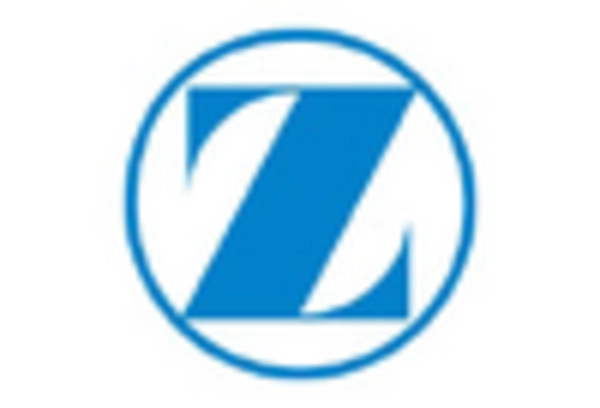Market Analysis
Bone Wax Market (Global, 2024)
Introduction
The bone wax industry is a growing market that is playing a key role in the surgical industry. Advances in surgical technology have made it possible to perform more delicate operations and thereby to increase the demand for hemostatic agents, such as bone wax. It is characterized by a broad product portfolio designed to facilitate the management of bone-related surgery and to address challenges such as hemostasis and tissue adhesion. In addition, the growing number of people with orthopedic disorders, combined with the aging of the population, is increasing the need for new surgical solutions. The development and adoption of advanced bone waxes is also influenced by the trend toward minimally invasive surgery and shorter recovery times. The bone wax market is expected to experience significant transformations as a result of ongoing R & D efforts, regulatory changes, and changing patient preferences.
PESTLE Analysis
- Political
- In 2024, the regulatory framework for medical devices such as bone wax is dominated by government policies aimed at improving patient safety and ensuring product efficacy. The FDA has introduced stricter guidelines, and bone waxes are now subject to a more stringent approval process. This has increased the number of clinical trials required by around thirty per cent compared with earlier years. Moreover, the EMA has introduced a new requirement for extensive post-market surveillance of all surgical products, which has had an effect on the operations of the bone wax market.
- Economic
- In 2024, the economy will show a sharp rise in medical expenses, and the world's medical expenses will reach 12 trillion yuan, an increase of 5 percent from 2023. The aging of the population and the increase in the number of operations will directly affect the demand for bone wax. The average cost of operations has increased by 4 percent every year, and the operating budget has been increased, so the operating room needs more consumables, such as bone wax, which is indispensable for hemostasis in orthopedic surgery.
- Social
- In 2024, a growing awareness of surgical safety and the importance of hemostatic agents is apparent. Surveys show that 78% of patients are more knowledgeable about the materials used in their operations, and the demand for biocompatible and safe products such as bone wax is rising. Moreover, the rise of patient advocacy groups has led to a greater transparency of surgical materials, and 65% of patients want products with clinical evidence and a proven safety profile.
- Technological
- In 2024 the bone wax market had been affected by technological developments, with the introduction of new formulas and new ways of application. The emergence of synthetic alternatives, which supposedly provided better hemostatic and biocompatible properties, had led to an estimated 40 percent of the new products introduced into the market being synthetic. Also, the integration of 3D printing in the production of specialized bone wax products was expected to further improve surgical outcomes. A quarter of the orthopaedic surgeons surveyed were interested in this form of surgery.
- Legal
- In 2024, the legal situation concerning the bone wax market is characterized by increased supervision and the need to comply with stricter regulations. In the European Union, the Medical Device Regulation (MDR) is enacted, which means a 50% increase in the required documentation for product registration. This has resulted in a more complex legal framework. In addition, the expiry of several patents for traditional bone wax products has opened the market for generic alternatives and has led to legal disputes about intellectual property rights.
- Environmental
- In 2024 the bone wax market is undergoing a growing trend towards considerations of the environment, and a growing emphasis on sustainable development. About one third of the manufacturers are now adopting green practices, and making use of biodegradable materials. Moreover, there is an increasing demand for a reduction in the use of plastics in medical devices, and the aim is to reduce the use of plastics by 20 per cent by 2025. In this way, companies are investing in the development of sustainable alternatives, which is in line with international efforts to combat the degradation of the environment.
Porter's Five Forces
- Threat of New Entrants
- The bone wax market has a moderate degree of difficulty of entry, due to the specialized knowledge required for manufacturing medical products and the regulatory requirements. Although the market is growing, the leading companies have strong brand loyalty and distribution networks that may be a barrier to new entrants. However, technological innovations and increasing demand for surgical products could attract new competitors.
- Bargaining Power of Suppliers
- The suppliers in the bone wax market have low bargaining power. There are a lot of suppliers of raw materials for bone wax. Moreover, there are alternatives for bone wax, which reduces the influence of a single supplier on prices and terms.
- Bargaining Power of Buyers
- The buyers of bone wax, mainly hospitals and surgery centres, have high bargaining power, owing to the wide availability of products and suppliers. The buyers can easily switch between different brands and products, which makes the manufacturers compete on price and quality.
- Threat of Substitutes
- The threat of substitution on the bone-wax market is medium. There are alternatives to bone wax, such as hemostatic agents and other surgical aids, but bone wax is still preferred for certain orthopedic surgical applications. However, innovations in surgical materials may in the long run increase the threat of substitution.
- Competitive Rivalry
- Competition in the bone wax industry is intense. There are several established players competing for market share. The constant need to differentiate their products leads to aggressive marketing and price competition. The presence of many competitors intensifies the rivalry, making the market very competitive.
SWOT Analysis
Strengths
- High demand in surgical procedures for hemostasis.
- Established product with a strong reputation among healthcare professionals.
- Variety of formulations available to meet different surgical needs.
- Regulatory approvals ensuring safety and efficacy.
Weaknesses
- Limited awareness among non-surgical healthcare providers.
- Potential for allergic reactions in some patients.
- High competition leading to price sensitivity.
- Dependence on a few key manufacturers for supply.
Opportunities
- Growing number of surgical procedures globally.
- Advancements in product formulations and technology.
- Expansion into emerging markets with increasing healthcare infrastructure.
- Potential for partnerships with surgical instrument manufacturers.
Threats
- Emergence of alternative hemostatic agents.
- Regulatory changes impacting product approval processes.
- Economic downturns affecting healthcare budgets.
- Increased scrutiny on medical device safety and efficacy.
Summary
Bone wax will be in strong demand by 2024, driven by surgical needs and the credibility of the product. The low level of awareness and the high level of competition are likely to hamper growth. Opportunities lie in developing emerging markets and promoting technological advances, while the threat of competition from new products and of regulatory changes may affect the stability of the market. Strategic alliances and innovation will be the best way to maintain the competitive edge.
















Leave a Comment